Correlation between the functional impairment of bone marrow-derived circulating progenitor cells and the extend of coronary artery disease
- PMID: 22776510
- PMCID: PMC3433309
- DOI: 10.1186/1479-5876-10-143
Correlation between the functional impairment of bone marrow-derived circulating progenitor cells and the extend of coronary artery disease
Abstract
Background: Bone marrow-derived circulating progenitor cells (BM-CPCs) in patients with coronary heart disease are impaired with respect to number and functional activity. However, the relation between the functional activity of BM-CPCs and the number of diseased coronary arteries is yet not known. We analyzed the influence of the number of diseased coronary arteries on the functional activity of BM-CPCs in peripheral blood (PB) in patients with ischemic heart disease (IHD).
Methods: The functional activity of BM-CPCs was measured by migration assay and colony forming unit in 120 patients with coronary 1 vessel (IHD1, n = 40), coronary 2 vessel (IHD2, n = 40), coronary 3 vessel disease (IHD3, n = 40) and in a control group of healthy subjects (n = 40). There was no significant difference of the total number of cardiovascular risk factors between IHD groups, beside diabetes mellitus (DM), which was significantly higher in IHD3 group compared to IHD2 and IHD1.
Results: The colony-forming capacity (CFU-E: p < 0.001, CFU-GM: p < 0.001) and migratory response to stromal cell-derived factor 1 (SDF-1: p < 0.001) as well as vascular endothelial growth factor (VEGF: p < 0001) of BM-CPCs were reduced in the group of patients with IHD compared to control group. The functional activity of BM-CPCs was significantly impaired in patients with IHD3 as compared to IHD1 (VEGF: p < 0.01, SDF-1: p < 0.001; CFU-E: p < 0.001, CFU-GM: p < 0.001) and to IHD2 (VEGF: p = 0.003, SDF-1: p = 0.003; CFU-E: p = 0.001, CFU-GM: p = 0.001). No significant differences were observed in functional activity of BM-CPCs between patients with IHD2 and IHD1 (VEGF: p = 0.8, SDF-1: p = 0.9; CFU-E: p = 0.1, CFU-GM: p = 0.1). Interestingly, the levels of haemoglobin AIc (HbAIc) correlated inversely with the functional activity of BM-CPCs (VEGF: p < 0.001, r = -0.8 SDF-1: p < 0.001, r = -0.8; CFU-E: p = 0.001, r = -0.7, CFU-GM: p = 0.001, r = -0.6) in IHD patients with DM.
Conclusions: The functional activity of BM-CPCs in PB is impaired in patients with IHD. This impairment increases with the number of diseased coronary arteries. Moreover, the regenerative capacity of BM-CPCs in ischemic tissue further declines in IHD patients with DM. Furthermore, monitoring the level of BM-CPCs in PB may provide new insights in patients with IHD.
Figures
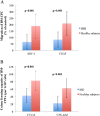
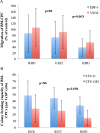
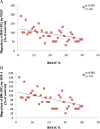
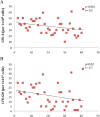
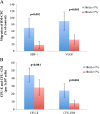
References
-
- Asahara T, Masuda H, Takahashi T, Kalka C, Pastore C, Silver M, Kearne M, Magner M, Isner JM. Bone marrow origin of endothelial progenitor cells responsible for postnatal vasculogenesis in physiological and pathological neovascularization. Circ Res. 1999;85:221–228. doi: 10.1161/01.RES.85.3.221. - DOI - PubMed
MeSH terms
LinkOut - more resources
Full Text Sources
Medical

